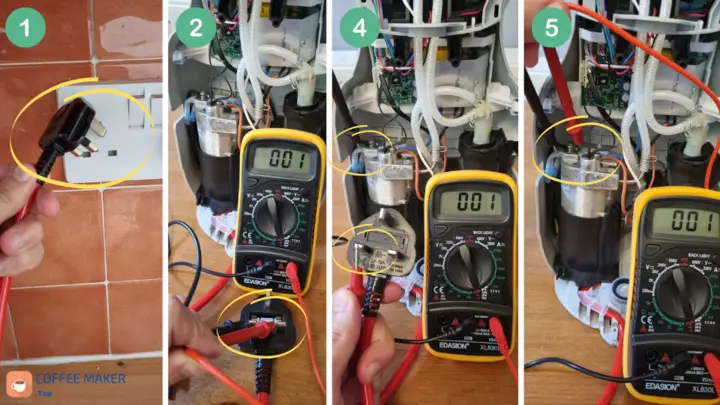Dolce Gusto coffee machines are among the most robust and durable capsule coffee machines. However, they are not exempt from experiencing problems from time to time. We’ve discussed this fault in our Dolce Gusto troubleshooting guide, albeit very superficially. That’s why today, we’re going to show you how to diagnose and troubleshoot the power failure of your Dolce Gusto.
Before we start, let’s define what we mean by a Dolce Gusto power failure: this fault refers to coffee machines that do not turn on the power button and do not produce any sound; “the coffee machine is dead”. We will also talk about those that light up slightly and then switch off after a few seconds.
NOTE: If your Dolce Gusto coffee machine is under warranty, you don’t need to read further; contact Dolce Gusto and order a new coffee machine. Both Delonghi and Krups offer a two-year warranty on their Dolce Gusto capsule coffee machines.
What happens to a Dolce Gusto coffee machine that won’t turn on?
When a Dolce Gusto does not turn on, its control board is not powered. The control board is the “brain” of the coffee machine, which is responsible for starting the water pump, the thermoblock, switching on the button light, etc. We say that it is not powered, not that it is faulty, although this could also be the case (we will see it later).
How can we be sure that the control board is not powered?
If a Dolce Gusto does not light up at all, the only component responsible is the control board. If the coffee machine lights up its power button, then the control board is live. If a coffee machine does not light up the power button but makes noises, then the control board is also live.
In a “dead” Dolce Gusto, the control board is not receiving any voltage, and we aim to find where the electrical current has been interrupted in the circuit.
Can it happen that the control board is powered, but the coffee machine does not switch on?
Yes, it could be the case that the control board of the Dolce Gusto receives voltage, but it is damaged and does not switch on at all. During the time I have been fixing Dolce Gusto coffee machines, I encountered a short-circuited coffee machine, and the microprocessor was damaged. I have also seen many cases where the capacitors on the board break, but we will talk about this later.
Dolce Gusto coffee machines have safety measures so that possible short circuits or power surges do not damage the control board.
How to find where the power is interrupted in a Dolce Gusto coffee machine
To find the place where the circuit is “open,” you will need to use a multimeter that has the option to measure continuity (most multimeters on the market have this option). Read this article if you have doubts about how to measure continuity.
Steps to follow (the Dolce Gusto must be unplugged at all times):
- Make sure that the plug you are using is working properly. You can do this by plugging in any other appliance and checking that it is working.
- If a fuse protects the cable of your coffee machine, check the continuity of this fuse. Touch both ends with the multimeter until you hear the beep.
- Disassemble your Dolce Gusto to expose all internal components.
- Check that the power cable is not damaged inside. Touch the multimeter to the pins of the cable and the thermoblock inlet.
- Check the continuity of the thermal fuses above the thermoblock. A bad fuse in one of these fuses is the most common.

It is most likely that one of the two fuses above the thermoblock has blown. If this is the case, replace it with a new one. The Dolce Gusto you see in the picture above has these fuses: SF129 10Amps 250V 133°C, which you can find on Amazon UK for 10 pounds, five units.
To replace them, you just have to disassemble the coffee machine, remove the screw that anchors them to the thermoblock, move the plastic cover, cut the fuse at the ends and solder a new one. Don’t be afraid of this little electrical job, because it is simpler than it looks. You can always ask someone to do it for you.
Problem with a faulty control board in Dolce Gusto
If you have measured continuity in the circuit and everything is correct, the problem is in the control board itself. As we mentioned earlier, thermal fuses protect the coffee machine in most cases. However, there are times when, due to the continuous use of the Dolce Gusto, the control board eventually breaks down due to wear and tear.
The most sensitive components of the Dolce Gusto control board are the capacitors, which tend to lose their capacitive power over time. It must be said that it is rare for a capacitor to break completely overnight. It is normal for the coffee machine to lose power day by day, with less water pressure and even causing the light on the power button to fade.

When we have this kind of problem with control plates, I advise replacing them with a new or second hand one by buying an old coffee machine. This new plate for a Mini Me costs £26.72, and these second hand coffee machines are sold for £10.
Check out this article on how to measure capacitance in capacitors.
Conclusion
If your coffee maker doesn’t turn on, you already know that the problem is related to the control board. Sometimes, when it turns on but shuts off or loses power, it also has a problem with the capacitors on the control board.
If you find that the circuit breaks before it reaches the control board, it is probably the thermal fuses which are easily replaceable.
